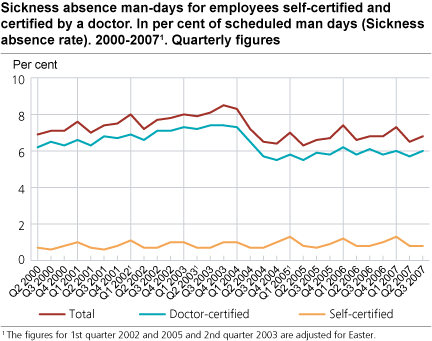Content
Published:
This is an archived release.
No change in sickness absence
The sickness absence remained unchanged at 6.8 per cent in the third quarter of 2007 compared to the third quarter of 2006.
The sickness absence for women rose from 8.3 to 8.4 per cent, while it remained stable for men at 5.6 per cent, the same level as in the third quarter of 2006.
The sickness absence in the third quarter of 2007 was 8.3 per cent lower than in the third quarter of 2001, the year when the agreement on an inclusive labour market was implemented.
Decrease in education and transport
Amongst the larger industries, the decrease in sickness absence was strongest in education with 4.6 per cent followed by transport with 4 per cent.
Real estate and public administration experienced a growth in sickness absence of 6.8 and 2.9 per cent respectively, but the level is still lower than the average for all industries.
Decreasing proportion of long-lasting absence
The proportion of doctor-certified sickness absence lasting more than 31 days within this quarter fell from 62.2 per cent to 61.5 per cent from the third quarter of 2006 to the third quarter of 2007. The proportion of self-certified sickness absence compared to the total sickness absence (self-certified and doctor-certified) rose from 10.8 per cent to 11.2 per cent.
Only minor changes in the sectors
The different sectors experienced only minor changes in sickness absence. However, the sickness absence in general government (including health enterprises) rose by 1.5 per cent. The health care sector (mainly health enterprises) saw sickness absence grow by 1.6 per cent, while the education sector (universities and university colleges) experienced a decrease of 2.6 per cent.
In local government, the education sector (primary and secondary education) had the strongest decline in sickness absence with 5.1 per cent, while the health care sector had an increase of 1.2 per cent.
The sickness absence level was highest in local government with 8.1 per cent and lowest in the private sector with 6.5 per cent.
Strongest decrease in oldest age groups
The doctor-certified sickness absence had the strongest decrease among 60-64 year-olds. The doctor-certified sickness absence fell by 4.3 per cent in this group, followed by a 2.5 decrease among 55-59 year-olds. Among 25-29 year-olds, this type of absence rose by 2.2 per cent.
The results are based on data on sickness absence certified by a doctor, as the survey on self-certified absence does not contain data on sickness absence by age.
The sickness absence rate measures the proportion of scheduled man-days lost due to own sickness. The statistics do not cover self-employed persons.
Tables:
- Table 1 Sickness absence man-days for employees self-certified and certified by a doctor. In per cent of scheduled man-days (Sickness absence rate). Quarterly figures. 2000-2007
- Table 2 Sickness absence man-days for employees self-certified and certified by a doctor, by sex. In per cent of scheduled man-days (Sickness absence rate). Quarterly figures. 2000-2007
- Table 3 Sickness absence man-days for employees self-certified and certified by a doctor, by industry and type of sickness absence. In per cent of scheduled man days (Sickness absence rate). Quarterly figures. 2000-2007
- Table 28 Sickness absence by type of absence(self-certified or doctor-certified) and duration within the quarter
- Table 33 Change in per cent of the sickness absence rate for employees self-certified and certified by a doctor, by industry and type of sickness absence. Quarterly changes. 2000-2007
Contact
-
Arbeidsmarked og lønn
E-mail: arbeidsmarked@ssb.no
-
Unn H. Høydahl
E-mail: unnh.hoydahl@ssb.no
tel.: (+47) 40 90 23 77

